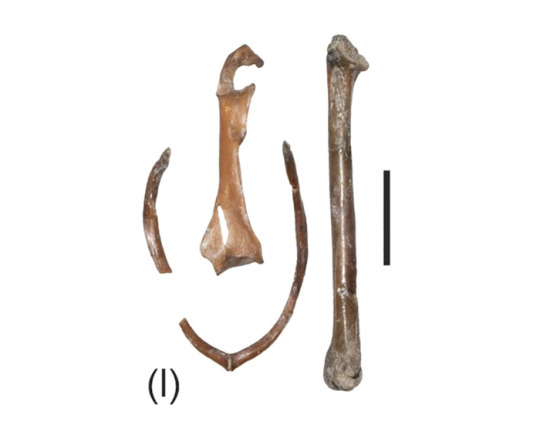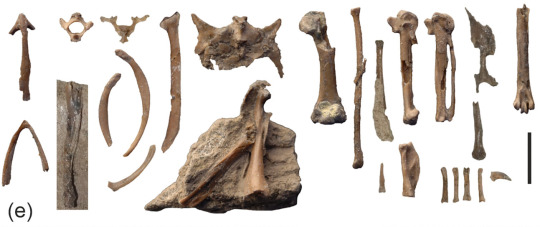#Eocypselus paulomajor
Text
Eocypselus paulomajor Mayr & Kitchener, 2024 (new species)

(Type specimen of Eocypselus paulomajor [scale bar = 5 mm], from Mayr and Kitchener, 2024)
Meaning of name: paulomajor = somewhat larger [in Latin]
Age: Eocene (Ypresian), 54.6‒55 million years ago
Where found: London Clay Formation, Essex, U.K.
How much is known: A few forelimb bones of one individual.
Notes: E. paulomajor was a close relative of apodiform birds (the group uniting swifts and hummingbirds). Members of the genus Eocypselus probably looked similar to modern swifts, though they had shorter wings and were better adapted for perching (whereas swifts prefer to cling to vertical surfaces such as cliff faces and tree trunks).
Two species of Eocypselus had previously been named: E. vincenti from England (also from the London Clay Formation) and E. rowei from the United States. Along with the also newly-named E. geminus and E. grandissimus, E. paulomajor suggests that a great diversity of apodiform-like birds lived during the Eocene in what would become the United Kingdom. E. paulomajor was larger than most other species of Eocypselus, but was smaller than E. grandissimus.
Reference: Mayr, G. and A.C. Kitchener. 2024. New fossils of Eocypselus and Primapus from the British London Clay reveal a high taxonomic and ecological diversity of early Eocene swift-like apodiform birds. Ibis advance online publication. doi: 10.1111/ibi.13323
46 notes
·
View notes
Text
Eocypselus geminus Mayr & Kitchener, 2024 (new species)

(Type specimen of Eocypselus geminus [scale bar = 5 mm], from Mayr and Kitchener, 2024)
Meaning of name: geminus = twin [in Latin, referring to its similarity to E. vincenti]
Age: Eocene (Ypresian), 54.6‒55 million years ago
Where found: London Clay Formation, Essex, U.K.
How much is known: Partial skeletons of two individuals, representing part of the skull and multiple limb bones.
Notes: E. geminus was a close relative of apodiform birds (the group uniting swifts and hummingbirds). Members of the genus Eocypselus probably looked similar to modern swifts, though they had shorter wings and were better adapted for perching (whereas swifts prefer to cling to vertical surfaces such as cliff faces and tree trunks).
Two species of Eocypselus had previously been named: E. vincenti from England (also from the London Clay Formation) and E. rowei from the United States. Along with the also newly-named E. grandissimus and E. paulomajor, E. geminus suggests that a great diversity of apodiform-like birds lived during the Eocene in what would become the United Kingdom. E. geminus differed from E. vincenti in minor details of the wing bones, from E. rowei in having relatively longer feet, and from E. grandissimus and E. paulomajor in being noticeably smaller.
Reference: Mayr, G. and A.C. Kitchener. 2024. New fossils of Eocypselus and Primapus from the British London Clay reveal a high taxonomic and ecological diversity of early Eocene swift-like apodiform birds. Ibis advance online publication. doi: 10.1111/ibi.13323
36 notes
·
View notes
Text
Eocypselus grandissimus Mayr & Kitchener, 2024 (new species)

(Type specimen of Eocypselus grandissimus [scale bar = 5 mm], from Mayr and Kitchener, 2024)
Meaning of name: grandissimus = largest [in Latin]
Age: Eocene (Ypresian), 54.6‒55 million years ago
Where found: London Clay Formation, Essex, U.K.
How much is known: Partial skeleton of one individual including several vertebrae, some forelimb bones, and a pedal phalanx (toe bone).
Notes: E. grandissimus was a close relative of apodiform birds (the group uniting swifts and hummingbirds). Members of the genus Eocypselus probably looked similar to modern swifts, though they had shorter wings and were better adapted for perching (whereas swifts prefer to cling to vertical surfaces such as cliff faces and tree trunks).
Two species of Eocypselus had previously been named: E. vincenti from England (also from the London Clay Formation) and E. rowei from the United States. Along with the also newly-named E. geminus and E. paulomajor, E. grandissimus suggests that a great diversity of apodiform-like birds lived during the Eocene in what would become the United Kingdom. E. grandissimus was noticeably larger than all other known species of Eocypselus.
It is possible that the type specimen of Parvulivenator, a bird from the London Clay Formation known from foot bones, represents a specimen of E. grandissimus, in which case the genus name Eocypselus would need to be replaced by the earlier-named Parvulivenator. (Parvulivenator was originally identified as a small falcon, but there is no strong evidence to support this.) However, there are enough differences between Parvulivenator and Eocypselus species with known foot bones that more specimens are needed to confirm or deny this possibility.
Reference: Mayr, G. and A.C. Kitchener. 2024. New fossils of Eocypselus and Primapus from the British London Clay reveal a high taxonomic and ecological diversity of early Eocene swift-like apodiform birds. Ibis advance online publication. doi: 10.1111/ibi.13323
38 notes
·
View notes